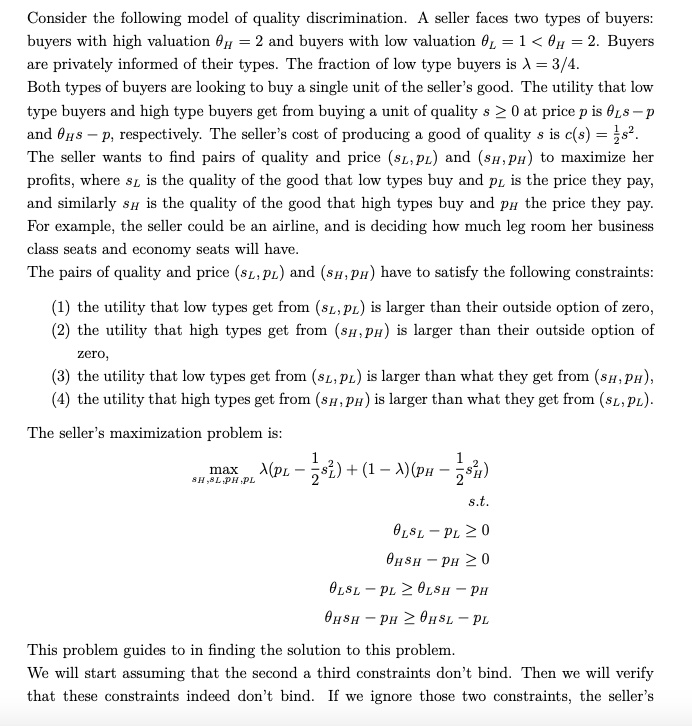Consider the folloadng model of quality discrimination. A seller faces two types of buyers: buyers with high 1valuation EH 2 2 and buyers with low valuation EL 2 l 1:: EH 2 2. Buyers are privately informed of their types. The fraction of low type buyers is A = 3,\". Both types of buyers are looking to buy a single unit of the sellesz good. The utility that low type buyers and high type buyers get from buying a unit of quality 3 E I] at price p is figs p and tips plI respectiyely. The seller's seat of producing a good of quality a is c(s} = 5.52. The seller wants to nd pairs of quality and price [smpgl and [smpgl to maximise her profits, where s1, is the quality of the good that low types buy and pig, is the price they pay, and similarly 5;; is the quality of the good that high typa buy and pH the price they pay. For example, the seller could be an airline, and is deciding how much leg room her business class seats and economy seats will have. The pairs of quality and price (5;, pL} and {53, pH} have to satisfy the following constraints: (1} the utility that low typm get from (5;, 31;} is larger than their outside option of zero, {2} the utility that high types get from {sg,pg) is larger than their outside option of zem, (3} the utility that law typm get from (shying) is larger than 1What they get from $3,103}, (4} the utility that high types get from [53, pH} is larger than what they get from (5;, pL}. The seller's maximization prehlenl is: l 1 max $pr - Est} + (1 - All}!!! - fir) 3H ,9L fill}! .131. s.t. ELSA: Pr. 2 HHS}: -PH 2 D 31.51. - PL 2 HLSH -PH 3H3}! - PH 3 HEEL - FL This preblenl guides to in nding the solution to this prob-Isol. We will start assuming that the second a third constraints don't bind. Then we will verify that these constraints indeed don't bind. If we ignore those two constraints, the seller's problem becomes: max SH,BL PH .PL X(PL - ,$1) + (1 - X)(PH - 584) s.t. OLSL - PL 2 0 OHSH - PH 2 OHSL - PL a) Argue that, in this simplified problem, the two constraints constrains must be satisfied with equality. Use these two constraints to solve for the prices pz and py at which the seller will sell to low and high types. The prices that you get should only depend on s and SH. b) Using your answer to part (a), argue that the seller's problem can be written as max A(OLSL - ,$2) + (1 - A)(OHSH - (OH - OL)SL - SH Taking first-order conditions in this expression, show that the optimal levels of quality sy and sz solve: X(OL - SL) - (1 - X)(0H - 01) = 0 = $1 = 01 1 _ _ACH -BL) = 2/3 A OH - SH = 0 = SH = OH = 2. (Recall that OH = 2, 01 = 1 and A = 3/4.) c) Using your answers above, conclude that the prices that the monopolist will charge are PL = OLSL = 2/3 and PH = OHSH - (OH - OL)SL = . Show that given these prices py and pr and these qualities s, and sL, the two constraints that we ignored are satisfied. Argue that the solution you found is a solution to the original problem with the four constraints








